The action and process of gardening or being in a garden surrounded by plants is indisputably good for one’s soul and overall wellbeing. Chelsea Barracks was designed around garden squares with these very thoughts in mind and perhaps, during these extremely challenging times, they are more important than ever. In light of this we have dug into the archives to share an interview from 2016 with famed rose grower, Philip Harkness.
Harkness Roses are behind some of the most exclusive roses ever created in the UK, including the rose used in Princess Diana’s wedding bouquet and the Queen of Bhutan rose, formally presented by the Duke and Duchess of Cambridge on their first official visit to the country. As one of the country’s leading rose breeders, Philip Harkness was the obvious choice to create a rose that perfectly symbolises the heritage and status of Chelsea Barracks.
Walking up the road towards the nursery you are greeted ba rosy scent that gradually wraps itself around your every sense. As you get closer, the roses begin to engulf what you can see, touch and feel. The rows upon rows of brightly coloured flowers look more like woven quilts and in this case, you can literally wake up to smell the roses.
As we arrived, we were welcomed by Philip Harkness and given a guided tour of the nursery, with the opportunity to learn about the art of growing some of the most popular roses in the country.
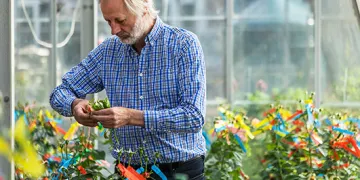
How do you go about creating a new rose?
“When we’re creating a new rose we genetically mix up all the genes and chromosomes of existing ones. We use the parent roses of our choice, not nature’s choice.”
Pollination
“First we select the ‘mother’ rose. The pollen (the male part) is placed onto the stigma, (the female part) which fertilises it and makes a seed pod. This process is called pollination which, in nature, is the job of bees.”
Seeding
“Pollination happens in late May/early June and the seed pods are ripe for harvesting in November. Every seed pod has 15 to 20 seedlings inside it, and we conduct about 5,000 pollinations so we end up with around 50,000 seeds that we then store over the winter.”
“In January, we sow the seeds in lines about two inches apart, only 60% will germinate so we have about 30,000 plants that will start growing in March. If we get 20 seeds from one seed pod, they will be 20 different roses; and, like brothers and sisters, they are all different. To get identical roses is very rare. I have 30,000 unique plants coming out every year. When they come to flower, if we like them, we move them into the next stage; field trials.
This takes between three to five years. We are able to test the plants in different conditions, to see which ones will survive; how beautiful they are, their smell, the size of the flower etc.”
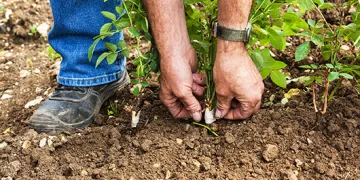
Selection
“We narrow the selection down to between 1,200 and 1,500 plants, growing five plants of each. We use root stock plants and draft our variety in. Taking the stem, we cut out the bud head and insert the sliver of bark. This is then drafted into the stem by making a T-shaped cut and sliding it in so that the cambium layers touch each other. The bark is tied in so that it fuses with the root stock. This grafting process happens in July.
The following January, we chop off the top of the root stock, so come June, you have the rose you wanted. Nearly every rose plant you buy for the garden will have gone through this process. From the time we do pollination to the time we have a plant to put on the market is about eight years.
How many times do you need to go through the trial and error process to achieve the perfect rose?
“For each new rose we put onto the market, we grow 12 to 15,000 for research, so it’s a very big investment. An awful lot of the mother plants used are steps on the way to the goal, they are not good enough to be introduced and don’t have the characteristics we’re looking for, but they are important building blocks on the way.”
How do you decide what roses to breed as parents?
“That goes back to what the basic objectives of breeding are. I made a decision in 1994 that we weren’t going to use any chemicals or fungicides to treat the plants. We therefore have to breed plants that are very healthy and have strengthand natural resilience so that if they get a disease they can recover. After health, we are looking for plants which have lots of flowers, in nice colours, with perfume where possible; this can be difficult with some colours. Basically, just well-behaved garden plants.”
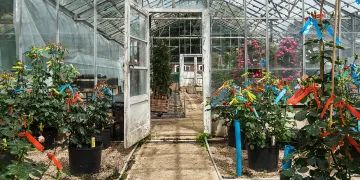
What are the parents of the Chelsea Barracks Rose?
“The mother is the Easy Going rose and the father is The Girl Guiding Centenary rose. We had a choice of flowers that had gone four to five years in the system, and then looked at ones in years six, seven and eight.”
How difficult is it to get the desired colour for a particular rose?
“It can be totally impossible sometimes. A lot of roses are not a consistent colour. If you see it in early flowering in June and then you see it in later flowering in September, the colouring will be different. The colour is affected by the day length, by light intensity, by the soil type, nutrients and some can vary quite a lot. When dealing with nature, you have to accept that there is an element of adaptability and variability because it’s adapting to its environment. You won’t get something entirely consistent. We have targets, sometimes you find you get something which you were notexpecting, sometimes it’s good, sometimes it’s bad.“
How do you name the roses?
Some rose names do not have a particular origin and are just chosen from a pool of names that we like. Other times, we create and name roses specifically for clients, including charities, like the British Lung Foundation in association with Princess Diana. This year, we did one for Barnardo’s, for their 150th anniversary. I like doing things for charity, as it’s important to help those less fortunate. We get new names and addresses for the mail order business and can often sell the name. For the Barnardo’s rose, if someone comes along and wants to buy it, they can, and a percentage of the sale will go to Barnardo’s. It’s similar for other charities and I’m quite happy to do that. We also did the Mary Berry rose this year. Often clients who commission a rose, will have a particular name in mind, as was the case for the Chelsea Barracks Rose. We’re naming one for Jane Austen next year for her 200th anniversary.
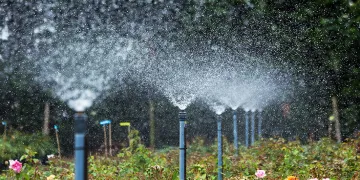
What do you find to be the most satisfying aspect of breeding roses?
“Having 30,000 seedlings growing, just about to flower and knowing nobody has ever before seen what you’re about to see; I think that has to be the most exciting part of any job imaginable. You don’t know what you’re going to behold. There can’t be anything more exciting than that.”
What are the differences between roses for gardens and roses found in florists?
““The roses in florists and garden centres are completely different. The ones used by florists are bred specifically for stem length, to produce so many flowers per square metres of glasshouse space, they’re bred specifically so that they last in a vase on display for a minimum number of days and so that they transport well, because most of those are grown in Kenya, or Columbia. Cut flowers are imported, and the breeding process is very different. If you put a cut flower in your garden, it will be useless. There’s very little in common between them.”
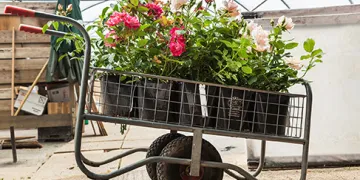
How do people get into the rose growing business?
“Some people have done horticultural courses, others have years of experience behind them. This job is not always based on what qualifications you have. Knowing what you’re doing and being confident in it goes a long way. You learn something new every year, if you accept that you are always learning, that you don’t know it all, then you are on the way to success.”
Philip makes it all sound so simple. However, this might be expected from someone who could be said to have roses in their blood. After cultivating roses for more than 125 years, Harkness Roses became a family firm 80 years ago and Philip has dedicated his life to mastering the skill and continuing the family legacy.
With that, I explore the nursery to take in the colours and smells that you notice long before you arrive.
For Philip's advice on how to care for and grow your own roses, have a look at the news section where we have shared his top tips.


